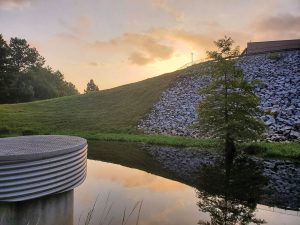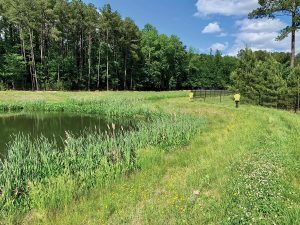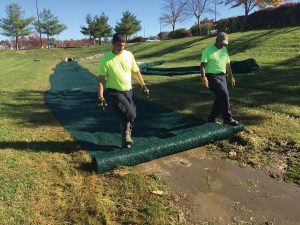— By Erin Zaske —
Understanding proper stormwater management.
Stormwater compliance is not optional. Many property owners are unaware that stormwater is regulated by the United States Environmental Protection Agency (EPA) through the Clean Water Act (CWA), and that they are required to inspect and maintain these systems. The importance of these regulations is significant as polluted stormwater runoff is one of the greatest threats to clean water in the U.S. Nearly 600,000 miles of rivers and streams and more than 13 million acres of lakes, reservoirs and ponds are considered impaired.

Erin Zaske, Aqualis
It’s also imperative for business owners to maintain their stormwater systems to prevent their parking lots from flooding, from sinkholes occurring, from trip-and-fall hazards and erosion as well as minimizing the potential for a Notice of Violation (NOV) — which can be a daily fine of up to $25,000.
What is stormwater and how is it regulated?
The EPA classifies stormwater systems as those that are publicly owned, discharge into waters of the U.S., and are not part of a sewage treatment plant such as Municipal Separate Storm Sewer Systems (MS4s). Any development disturbing 1 acre or more of land requires the implementation of stormwater control measures (SCMs) or best management practices (BMPs).
 Stormwater originates from a precipitation event and travels multiple pathways before entering the ground or surface waters. An increase in land development in recent years has increased the amount of paved or impermeable areas, such as parking lots, roads and rooftops, and ultimately decreased infiltration. Because of the prevention or limitations of infiltration, surface runoff has increased and can lead to detrimental impacts downstream.
Stormwater originates from a precipitation event and travels multiple pathways before entering the ground or surface waters. An increase in land development in recent years has increased the amount of paved or impermeable areas, such as parking lots, roads and rooftops, and ultimately decreased infiltration. Because of the prevention or limitations of infiltration, surface runoff has increased and can lead to detrimental impacts downstream.
Additionally, if stormwater systems are neglected, a property owner or manager may receive an NOV to inform the owner or manager of a violation of the stormwater management ordinance. This notice will detail what part of the stormwater ordinance was violated, when and where the violation was observed, and any necessary actions required. It may also include fines or penalties depending on the severity of the violation and prior history of the responsible party.
The National Pollutant Discharge Elimination System (NPDES) permit program, established under the federal CWA, controls water pollution by regulating sources that discharge pollutants to waters in the U.S. Individual municipalities are required to apply for NPDES permit coverage to operate the stormwater sewer systems and develop and implement a stormwater management programs.
The importance of proper stormwater management
Owners and property managers are legally responsible for ensuring the stormwater assets installed or built on their property are properly maintained and continually function as they were designed. For years, stormwater management primarily focused on facilitating water into a pipe and away from a site as quickly as possible. In recent years, improved techniques have been introduced to decrease the many negative impacts downstream on both the environment and developed areas, such as neighborhoods and communities.
 In most cases, properties have an Operations and Maintenance (O&M) Agreement that is developed between the property owner and the regulatory body and includes certain criteria that must be met with respect to the maintenance of a stormwater system. An O&M agreement ensures tasks will be completed properly while allowing you to run your business or manage your property.
In most cases, properties have an Operations and Maintenance (O&M) Agreement that is developed between the property owner and the regulatory body and includes certain criteria that must be met with respect to the maintenance of a stormwater system. An O&M agreement ensures tasks will be completed properly while allowing you to run your business or manage your property.
Comprehensive post-construction stormwater management can be divided into the following four elements, all of which work together in a properly implemented stormwater management plan: inspections, maintenance, repairs and consulting.
1. Inspections – understanding the system and determining its current condition
Once a stormwater system has been constructed, initial and annual questions to be answered by the property owner or manager include:
- Is the site required to submit an annual inspection report of the stormwater system?
- What qualifications are required of the inspector?
- When was the last inspection performed on the stormwater system?
- Who performed the inspection?
- Is the stormwater system currently inspected? If so, how frequently?
- Does the municipality perform annual inspections to the stormwater system?
A qualified stormwater inspector should perform all inspections and document it. Any deficient items should be corrected based on the recommendations of the inspector. The inspection will also determine the appropriate maintenance that is required for the facility.
2. Maintenance – a customized program to meet the needs of the system and prevent further damage
Stormwater assets must be properly maintained to ensure they operate correctly and provide the water quality treatment for which they were designed. Routine maintenance will prevent costly rehabilitative repairs that result when facilities are neglected.
Depending on where your facility is located, most of the stormwater maintenance includes scheduled vegetative management, trash and debris pickup and/or underground vault cleanings.
It is important that the appropriate maintenance plan is implemented to promote a functional stormwater system for an extended lifetime as well as keeping it aesthetically pleasing. The following questions should be considered when implementing a stormwater maintenance plan:
- What are the needs of the stormwater system onsite?
- Are there any maintenance requirements based on the location of the system?
- What is the property owner’s budget for proper maintenance?
Maintenance is essential to the proper function of each individual stormwater system, and there are many advantages to implementing a maintenance program, including:
- Ensuring the BMP is functioning as designed
- Complying with local regulations
- Minimizing any potential for a Notice of Violation
- Limiting the cost and size of repairs within the lifetime of the BMP
- Maintaining the aesthetic value of the asset
- Minimizing environmental risks and accompanying liability to the owner or property manager
Stormwater maintenance personnel must be qualified to properly maintain stormwater assets. Inadequately trained personnel may incur additional maintenance costs with the potential for overlooking critical deficiencies with the overall operations of the facility.
3. Repair – correcting deficiencies to ensure a functional and maintainable system
Repairs occur due to a localized system issue or failure, which oftentimes are the result of neglect, improper preventative maintenance, age or defect. There are two different types of repairs – restoration and rehabilitation.
 Restoration repair consists of a variety of isolated or small-scale corrective maintenance and work needed to address operational problems. I can vary from treatment of invasive plants to erosion repair. It may also include component replacement due to aging infrastructure, damage severity or repeat failure or patching occurrences.
Restoration repair consists of a variety of isolated or small-scale corrective maintenance and work needed to address operational problems. I can vary from treatment of invasive plants to erosion repair. It may also include component replacement due to aging infrastructure, damage severity or repeat failure or patching occurrences.
Rehabilitation repair addresses large-scale noncompliance corrections or the need for major improvements due to deficiencies or failures of the system. This work can include reconstruction, large scale debris, vegetation or vector removal, runoff redirection or vactor, jetting and wastewater pumping.
Stormwater retrofits, although less common, may also be necessary. Retrofits occur when a BMP needs to be installed where there was not one previously at a site, or it may include small-scale changes or redesigns in part of the stormwater system to allow optimized water quality, runoff reduction, filtration or retention capabilities. Retrofits likely require professional engineers during the entirety of the process.
4. Consulting – protecting and maximizing the value of your investment in stormwater management
Changes in stormwater regulations occur frequently. A property owner should periodically review the regulations coinciding with any properties and take advantage of the benefits from a proper stormwater management plan, including waivers or credits.
To implement the best stormwater management program for your facility, a property owner should partner with a stormwater company whose employees are trained and certified to ensure systems function correctly.
— Erin Zaske is the chief development officer at AQUALIS, the nation’s leader in water resource management delivering stormwater and wastewater management services to retail, commercial, industrial, municipal, healthcare and educational facilities. For more information, visit www.aqualisco.com.

